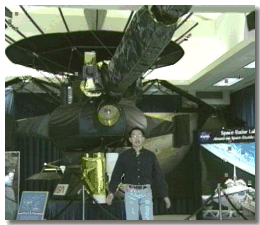
Galileo Mission

They named it "Galileo," after the discoverer of Jupiter's moons.
Launched from the shuttle in 1989, Galileo arrived at Jupiter in 1995.
It made looping trajectories around the planet and its moons, and documented previously unknown processes.
As Galileo arrived, the first probe ever sent by humans into the atmosphere of a gas giant separated, and flew down into the clouds.
It turned out to be a region much drier than the researchers expected after all those massive thunderstorms seen by Voyager.
|
Torrence Johnson What we have found...by comparing the probe data with the data from the instruments on the orbiter, is that Jupiter has tremendous variations in its humidity, much as the Earth does, of course, between things like the Sahara desert and tropical rainforests. There are other areas on Jupiter that are much wetter and on average we now think that Jupiter has a lot of water, it just wasn't in the place where the probe went in. So we now believe in fact that in an interesting respect, Jupiter's atmosphere actually is engaging in some of the same exchanges of energy that the Earth's atmosphere does through what's called "moist convection", that is, the evaporation of water and the condensation of water. What's different at Jupiter is that the energy for all this is not mostly coming from the Sun evaporating the oceans as it does on the Earth but from Jupiter's internal energy source, which is a result of its early, very, very energetic history when it collapsed from a ball of gas and dust, became very, very hot, almost star-like in fact... |
All that energy, plus Jupiter's vast gravitational pushes and pulls make the moons come to life in spectacular ways.
Io has more than 300 volcanoes, some with lava fountains spouting more than a mile above the surface.
On Earth they reach a few hundred meters at most.
|
Torrence Johnson What we've been able to do with the Galileo spacecraft and basically be a volcano observatory, watching the surface of this strange moon change literally before our eyes. |
Second moon out from Jupiter, icy Europa, which we already knew had some strange cracked patterns from the Voyager images...
|
Torrence Johnson We got close with Galileo what we saw was many of these cracks or ridges running across the surface and there are huge areas on Europa's surface where the surface apparently has been melted and things very much like ice rafts or icebergs have broken off from the edges of other parts of the icy crust ...moved and rotated. |
|
Claudia Alexander The pictures that they did get were, like, oh, well there's a lot fewer craters than we thought. This is a surprise, the surface must be younger than the three and a half billion years that we thought. And then the next orbit they went by they took more pictures, and it's like, oh well, gee, it's a lot younger than we thought, maybe, maybe it's even one billion year old. But the age dropped with every pass that we went by, the age of Europa began to get younger and younger, until the investigators were talking about maybe it's presently active, and maybe we should be targeting to try to catch one of these geysers suddenly open up and we could fly by and see the water coming out right presently. |
|
Torrence Johnson Putting all that data together makes a very strong case for there being a liquid ocean some 100 kilometers or 60 miles deep underneath that ice crust on Europa. It's a very exciting prospect. One of our big surprises with Ganymede came from the measurements from the magnetometer, which measures magnetic fields. We detected that Ganymede has its own magnetic field. It isn't just affecting the Jupiter field, but it has its own field, a sort of a bar magnet stuck inside it, deep inside... |
|
Claudia Alexander For it to have a magnetosphere it can't be frozen solid because what has to happen is that inside there has to be motions, turning over. Uh, we've never seen an icy moon with a magnetosphere; in fact, we've never seen any moon with a magnetosphere. |
The explanation for all these surprising phenomena seems to be that our solar system has other
ways of heating worlds, powering volcanoes, creating liquid water... and, just maybe, enabling
life to begin than with sunlight on the surface of a planet.
Torrence Johnson
These objects are being distorted by the tremendous gravitational forces of this big planet
Jupiter that they're orbiting. And as they move around Jupiter they get a little closer to
Jupiter at some point and they were a bit further away from Jupiter at other points in the orbit.
And so their crusts and their interiors are continually being flexed and pushed in and out. That
creates friction inside the body and that creates heat. And that's one of the things that's
producing this immense amount of volcanic activity on Io.
When you go to Europa there's less of this pushing and pulling going on because Europa is a
little further away from Jupiter than Io is. But that's still probably enough to heat up the icy
crust and the interior rock below and probably is one of the major players in keeping a liquid
layer ocean liquid on Europa.
As we'll see, sending an orbiter to Europa, and figuring out how to send a robot down into that
icy ocean is one possible future mission under consideration.
Project Scientist, Galileo
Jet Propulsion Laboratory, NASA/Caltech
![]()